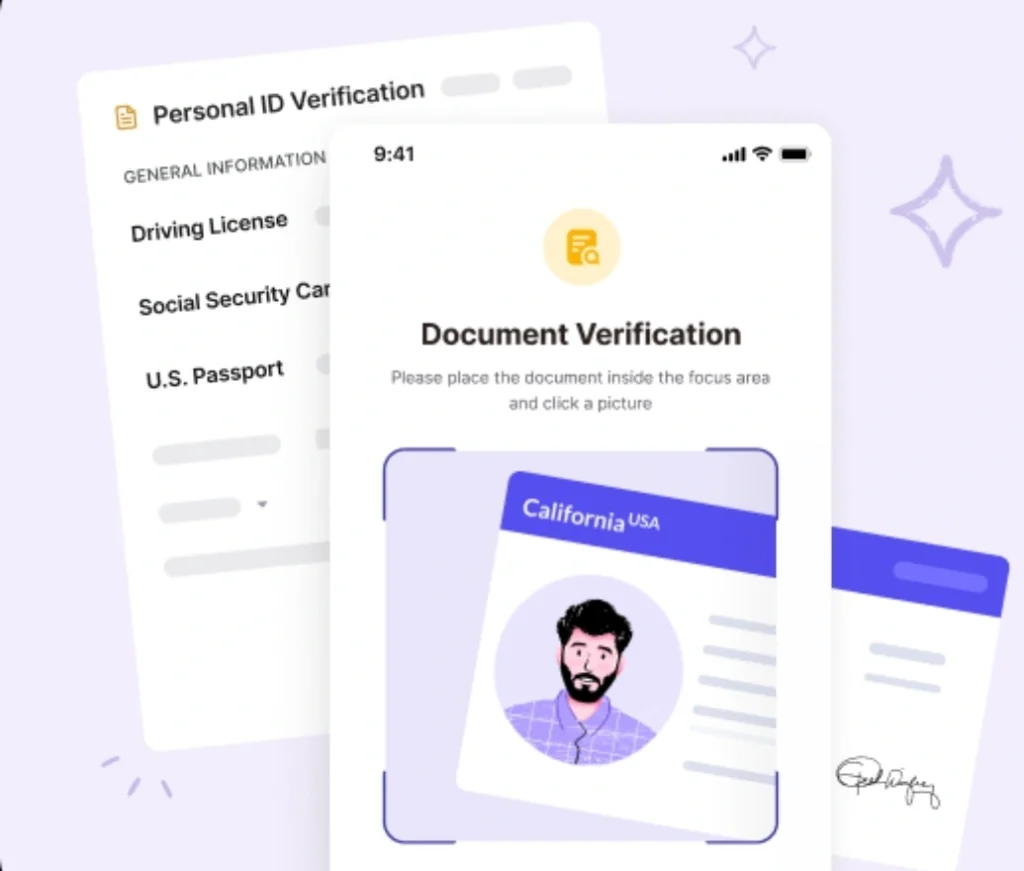With data breaches and other identity theft and fraud on the rise, more organizations are turning to identity verification and authentication technologies to stay safe. While these approaches are great for both identity fraud and theft and protecting systems and resources, they each have their unique strengths and purposes.
Here, we’ll take a closer look at identity verification and identity authentication together. We’ll break down what each term means, how they function, and their roles in a comprehensive identity security strategy and ensure compliance of business processes with Know Your Customer (KYC) and Anti-Money Laundering (AML) regulations.

Understanding identity verification
Identity verification (IDV) is about ensuring people are who they claim to be. How this is done can vary widely based on the industry, use case, company, and user. For social media accounts, for instance, one company might ask users to provide their date of birth and social security number (SSN) during onboarding, while another might require a photo of the user’s driver’s license and a selfie to verify their verified identity elsewhere.
Digital identity verification has become a common feature thanks to advances in secure data collection and processing methods. In multiple ways, companies can now detect if you are seeking access to their systems. This might involve collecting and validating some digital documents, government certificates, or company licenses.
Checking your personal information against authoritative databases and sometimes even asking for a selfie to confirm who is attempting verification can also serve this purpose.
Here are a few benefits of identity verification solutions:
- Increased customer confidence: With strong identity verification processes, customers feel safer and know the company is trying to prevent fraud and protect their information.
- Streamlined process: Using Digital ID verification, users can submit files quickly and avoid any unnecessary delay in processing those materials or time wasting.
- Reliable regulatory compliance: Through rigorous customer identity verification, companies could fulfill their obligations for KYC and prevent money laundering.
- Reduced risk: Accurate ID checks reduce risk. With reliable sources, your business can make better decisions.
Identity verification methods
There are three common identity verification methods:
Document verification
For proof of identification, national bank statements, driver’s licenses, and passports are examined. Holographic images, watermarks, embossed seals, and type fonts specify characteristics on these documents that help determine their authenticity.
Third-party sources are used to verify personal information such as one’s name, age, date of birth, and place of residence. This information is often found within official identity documents or provided by customers when they apply to open a new bank account.
Biometric verification
Biometric verification is a way to confirm someone’s ID by using their unique physical traits, such as the shape of their face and the patterns of their fingerprints. It’s unbelievable how amazing it is—when you take a photo with filters off, facial recognition looks at features individually before matching them against a database of known images.
However, the fingerprint scanning device performs fingerprint scanning checks on the original fingerprint maps against data in storage. These methods are super accurate and convenient, making the whole process quick and easy for users.
Database checks
Database checks are another key part of identity verification. This means comparing any person’s name and date of birth he self-reported with information sources like government databases or credit bureaus. But in this kind of check, there is an obvious duplication.
Traditional personal checks reveal anything that might make one suspicious about the provided details. It’s like a double-check to make sure the details are legitimate and helps catch any dissimilarities or possible fraud.
Understanding authentication
Identity authentication takes a different approach and focuses on the authentication factors preventing fraudsters from hacking genuine accounts. It works by asking customers to perform actions only they can do, such as providing specific letters from a memorable word.
However, this method relies on customers supplying and remembering this information when they open an account.
Difference between identity verification and authentication
Although they sound similar and often go hand in hand, there are major differences between the identity verification process and authentication processes. Verification is about establishing a legitimate user identity, while authentication prevents unauthorized users from accessing a system. Let’s compare them in a few key areas.
Purpose
- Verification confirms that an individual is who they claim to be by checking the authenticity of their proof of identity.
- Authentication determines if someone trying to access an account is actually authorized to do so.
Data type used
- Identity verification typically involves official documents, such as government IDs or a live photo, to prove a person’s physical identity.
- Authentication may not be tied to physical identity at all; it can involve passwords or possession of a code or key.
Identity timeline
- Verification happens at a specific point in time, usually during onboarding to establish identity, with possible re-verification at critical moments.
- Authentication is an ongoing process to continually validate a person’s identity for access to systems and resources.
Types of authentication methods
There are three common approaches to authenticate customers:
- Passwords: Customers provide information only they should know, like a password, memorable word, or answers to security questions (e.g., where did you go to school).
- OTP: Customers use a phone authentication app on a device only they have access to, such as a personal mobile phone or card reader. They typically supply a one-time password sent to or generated by the device, often via SMS.
- Biometric authentication: Customers are authenticated using unique biometric data like facial recognition, iris scans, or fingerprints. They may be asked to take a photo to match against one or multiple selfies they submitted previously.
Identity verification vs authentication
Verification confirms an individual user’s identity using official documentation or live photos, while authentication determines if someone is authorized to gain access to an account using passwords or codes. Verification happens at onboarding or during high-risk events, whereas authentication is an ongoing process. Together, they ensure both the legitimacy of access accounts and the continuous security of user access.
Identity verification is used when onboarding new customers, during high-value transactions or account changes, database verifications, and to comply with regulatory requirements such as KYC and AML. Authentication, on the other hand, is employed for logging into accounts, accessing sensitive information, or performing transactions and as an ongoing measure to prevent account takeover and maintain security.
Robust digital identity verification processes instill confidence in customers by ensuring stringent checks for new accounts and high-value transactions, safeguarding their personal information, offline identities, and assets. Digital solutions streamline document submission and approval, enhancing user experience and boosting conversion rates through efficient processes.
Compliance with KYC and AML regulations is assured, mitigating risks of penalties and demonstrating adherence to legal standards. By verifying data against such information sources as government databases, businesses lower their exposure to the dangers of fraud or false transactions. This enables them to make better-informed decisions, and also trust with their stakeholders remains intact.
Identity verification and authentication in compliance
Identity verification and authentication are crucial for businesses to ensure regulatory compliance and comply with legal requirements, especially regulations like KYC and AML.

HyperVerge’s solutions make this easier by using advanced AI technology to verify user identities accurately and quickly. This helps businesses ensure they’re meeting legal standards while keeping transactions secure and building trust with their customers.
Conclusion
Identity verification is a process in which a person’s true identity is determined through official documents, such as passports or biometric data. In contrast, identity authentication validates a user’s identity continuously by accessing secure data capture passwords or biometric scans.
Companies that implement both digital identity verification solutions and services become more secure, easily meet various rules, and build trust with customers by ensuring their data is protected.
Learn how HyperVerge’s advanced identity verification solutions can streamline compliance processes and enhance customer satisfaction and security.
Explore HyperVerge Identity Verification Solutions for more information.





